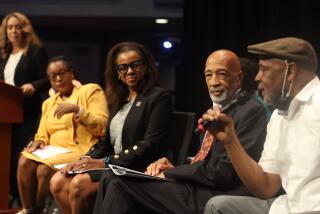Recognizing Hate Crimes Is 1st Step to Preventing Them
- Share via
Despite boasts of being a dynamic racial melting pot, the numbers suggest Southern California has a long way to go. Reported hate crimes in Los Angeles County rose 25% last year. A strong majority of Los Angeles residents believe race relations in the city are less than ideal--and nearly one-third think they are getting worse. Not very encouraging.
Late last month, the Los Angeles County Human Relations Commission identified the Antelope Valley and Van Nuys as two of four so-called hate crime clusters, areas where the number of reported incidents rose disproportionately. Attacks on African Americans in the Antelope Valley have been well chronicled and eight members of skinhead gangs have been convicted. Less publicized, but no less serious, have been attacks in Van Nuys, which more than doubled from 15 in 1995 to 34 in 1996.
In the San Fernando, Santa Clarita and Antelope valleys, reported hate crimes increased about 18% from 190 in 1995 to 224 in 1996. Just in the San Fernando Valley, reported incidents rose from 157 to 172. Part of the increases can be explained by greater sensitivity. Police agencies and even victims are more likely now to report crimes based mostly on race, gender, sexuality or religion. Even so, the numbers suggest growing tension, particularly in neighborhoods where change is greatest.
That tension was reflected in a recent Los Angeles Times poll that found that 49% of respondents consider Los Angeles a segregated city and that more than half don’t think civic leaders are doing enough to improve the situation of blacks and other minorities. True enough, but the ultimate responsibility for healing racial wounds lies with everyday citizens. Efforts from on high have little impact if no one in the neighborhoods thinks they’re worth joining.
Recognizing the region’s problems is the first step toward repairing them. But it requires residents and officials to work together. In Glendale, for instance, a rash of attacks sparked immediate action and an aggressive reporting system was born. Hate crimes in the city dropped from 11 in 1995 to seven in 1996. Southern California’s diversity gives it the vitality and depth of experience that make it world-class. Yes, it requires more effort, but it’s worth it.
More to Read
Sign up for Essential California
The most important California stories and recommendations in your inbox every morning.
You may occasionally receive promotional content from the Los Angeles Times.










